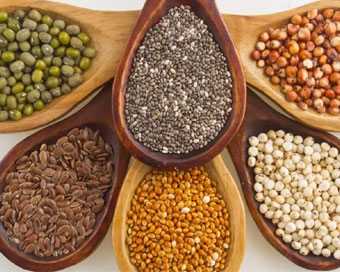| July 2, 2023 | IANS - New Delhi |

In recent years, there has been a resurgence in interest around millets -- a group of small-seeded grains that have been consumed in India for millennia.
Once deemed as 'coarse grains' and overshadowed by the advent of high-yielding crops, millets are now gaining global recognition for their nutritionally superior profiles and environmental sustainability.
Recently, in March 2023, a global conference was held, where, in line with the ongoing International Year of Millets, millets from India were proudly re-branded as 'Shree Anna' and 'Nutri-cereals'. Millets have gained immense importance worldwide due to their significant contributions to nutritional security and sustainable agriculture.
Historical Context and the Impact of the Green Revolution
Millets have been an integral part of Indian cuisine since ancient times, with a rich history of cultivation spanning over 5,000 years. Traditionally grown in dry regions with low rainfall, millets such as Ragi (Finger millet), Jowar (Sorghum), Bajra (Pearl millet), and Foxtail millet have been consumed in various forms, including rotis, porridges, and gruels. However, with the advent of the Green Revolution and the promotion of high-yielding crops like rice and wheat, millets gradually lost their prominence and were labelled as 'orphan crops' -- less consumed and nearly forgotten. Over the years, the proportion of millets in total cultivated grains decreased from approximately 40 per cent to around 20 per cent.
Millet cultivation areas yielded to the cultivation of commercial crops, such as oilseeds, pulses, and maize, exacerbating the decline in millet production. This shift created a pressing need to revitalize millets by enhancing their nutritional value and reaffirming their status as a valuable component of a wholesome diet.
Nutritional Relevance and Health Benefits
Amid the prevailing global health crisis marked by lifestyle diseases, the resurgence of millets is both apt and timely. Millets, being predominantly gluten-free and abundant in dietary fibre, offer a wealth of essential vitamins and minerals like calcium, iron, magnesium, and phosphorus. Their low glycemic index makes them an excellent choice for the growing number of individuals with diabetes, while their impressive antioxidant content further enhances their nutritional value.
As the world grapples with health concerns stemming from dietary habits, the revitalization of millets presents a promising solution to address these challenges. By incorporating millets into diets, individuals can benefit from their diverse nutritional composition and contribute to the prevention and management of lifestyle-related illnesses. Millets have the potential to play a significant role in improving the overall health and well-being of individuals, offering a sustainable and nutritious alternative to mainstream grains.
Environmental Resilience and Agricultural Sustainability
The environmental resilience of millets and their contribution to sustainable agricultural practices are of paramount importance. These remarkable grains possess unique characteristics that make them highly adaptable to challenging conditions. With their minimal water requirements and ability to withstand drought, millets offer a sustainable solution for regions facing water scarcity. Moreover, their natural resistance to pests and diseases reduces the need for chemical inputs, minimizing the environmental impact associated with conventional farming practices.
Millets thrive in marginal soils and are capable of flourishing in areas where other crops struggle to survive. This resilience makes them an ideal choice for regions vulnerable to erratic weather patterns and climate change impacts. By cultivating millets, farmers can diversify their income sources, mitigating the risks associated with relying solely on a single crop. This diversification not only enhances the economic resilience of farmers but also contributes to a more balanced ecosystem.
Furthermore, the cultivation of millets fosters soil health and fertility. Their deep-rooted nature helps improve soil structure and nutrient retention, reducing soil erosion and degradation. This, in turn, supports the long-term sustainability of agricultural practices and preserves the ecological balance of the surrounding environment.
The adoption of millets as a sustainable crop offers a multitude of benefits, not only for farmers but also for the overall ecosystem. Their minimal water requirements, resistance to pests, and adaptability to challenging environments make them an environmentally sound choice. By promoting the cultivation and consumption of millets, we can foster agricultural practices that minimize environmental impact, ensure long-term sustainability, and contribute to the preservation of our natural resources for future generations.
Revival Initiatives and Global Leadership
India has embarked on a transformative journey to elevate millets to the forefront of its food and agricultural policies, demonstrating a firm commitment to their revival.
Through government initiatives like the National Food Security Mission, Paramparagat Krishi Vikas Yojana, and the Millets Mission, a comprehensive framework has been established to boost millet production, offer technical assistance, and forge strong market connections. These visionary efforts are complemented by ingenious strategies such as supporting start-ups and entrepreneurs in crafting innovative millet-based recipes and value-added products. Furthermore, the creation of meticulously crafted e-catalogues targeting specific countries has facilitated the global promotion of Indian millets and their diverse derivatives.
In a significant milestone, India has recently forged a partnership by signing a Statement of Intent (SoI) with the United Nations World Food Program (WFP). This collaboration aims to mainstream millets and solidify India's position as a global leader in knowledge exchange pertaining to millet cultivation and consumption. This collaborative effort reflects India's dedication to not only reviving the significance of millets domestically but also advocating for their recognition and adoption worldwide.
In essence, India's comprehensive approach to reviving millets encompasses policy support, entrepreneurial encouragement, international promotion, and knowledge-sharing initiatives. By embracing these transformative measures, India not only sets an inspiring example for other nations but also paves the way for a future where millets reclaim their rightful place as a cornerstone of sustainable agriculture and nutrition security. India is poised to play a pivotal role in shaping global discourse and driving advancements in millet-related practices.
Conclusion: Future Prospects
As the world, including India, grapples with the dual challenges of ensuring sustainable agriculture and achieving nutrition security, millets offer a promising and viable solution. The revival and mainstreaming of these nutrient-rich, resilient grains have the potential to not only diversify India's food basket and improve farmers' incomes but also pave the way for a more resilient, sustainable, and health-focused food system. Thus, the revival of millets signifies a transformative path -- a path that champions sustainable agricultural practices while simultaneously addressing health and nutritional needs of the future generations.
Tweet












